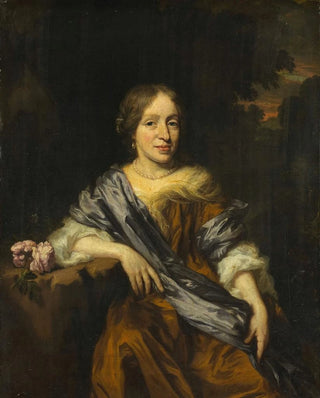Art print | Portrait of Catharina Pottey, sister of Willem and Sara Pottey - Nicolaes Maes


View from behind

Frame (optional)
Portrait of Catharina Pottey, sister of Willem and Sara Pottey - Nicolaes Maes – Captivating Introduction
The "Portrait of Catharina Pottey, sister of Willem and Sara Pottey" by Nicolaes Maes is an iconic work that transports the viewer into an era where art and everyday life intertwine with delicacy. This painting, embodying the refinement of 17th-century Dutch art, offers a window into the world of bourgeois portraits, where every detail is carefully crafted to reveal not only the physical appearance but also the personality and social status of the subject. Catharina Pottey, a central figure in this masterpiece, is depicted with grace and dignity that testify to Maes's skill in capturing human essence. Through this work, the artist invites us to explore the subtleties of family life and social relationships within Dutch bourgeoisie.
Style and uniqueness of the work
Nicolaes Maes's style is characterized by a realistic approach and meticulous attention to detail. In this portrait, the brightness of the colors and the finesse of the textures create an atmosphere that is both warm and introspective. Light plays a fundamental role, illuminating Catharina's face in a way that evokes a certain softness while highlighting the delicate features of her face. The clothing she wears, rich in nuances and details, also reveals her social status. Maes, a master in the art of representation, manages to infuse his subject with life and depth that transcend the simple act of painting. Every brushstroke seems to tell a story, and every exchanged glance between the viewer and the portrait creates a strong emotional connection, allowing for a complete immersion into the universe of the work.
The artist and his influence
Nicolaes Maes, born in 1634, is one of the prominent figures of the Dutch Golden Age. A pupil of Rembrandt, he developed a unique style that combines chiaroscuro with a sensitivity characteristic of his era. His work is distinguished by his ability to depict daily life with psychological depth, transforming mundane scenes into true moments of visual poetry. By painting bourgeois portraits, Maes

Matte finish

View from behind

Frame (optional)
Portrait of Catharina Pottey, sister of Willem and Sara Pottey - Nicolaes Maes – Captivating Introduction
The "Portrait of Catharina Pottey, sister of Willem and Sara Pottey" by Nicolaes Maes is an iconic work that transports the viewer into an era where art and everyday life intertwine with delicacy. This painting, embodying the refinement of 17th-century Dutch art, offers a window into the world of bourgeois portraits, where every detail is carefully crafted to reveal not only the physical appearance but also the personality and social status of the subject. Catharina Pottey, a central figure in this masterpiece, is depicted with grace and dignity that testify to Maes's skill in capturing human essence. Through this work, the artist invites us to explore the subtleties of family life and social relationships within Dutch bourgeoisie.
Style and uniqueness of the work
Nicolaes Maes's style is characterized by a realistic approach and meticulous attention to detail. In this portrait, the brightness of the colors and the finesse of the textures create an atmosphere that is both warm and introspective. Light plays a fundamental role, illuminating Catharina's face in a way that evokes a certain softness while highlighting the delicate features of her face. The clothing she wears, rich in nuances and details, also reveals her social status. Maes, a master in the art of representation, manages to infuse his subject with life and depth that transcend the simple act of painting. Every brushstroke seems to tell a story, and every exchanged glance between the viewer and the portrait creates a strong emotional connection, allowing for a complete immersion into the universe of the work.
The artist and his influence
Nicolaes Maes, born in 1634, is one of the prominent figures of the Dutch Golden Age. A pupil of Rembrandt, he developed a unique style that combines chiaroscuro with a sensitivity characteristic of his era. His work is distinguished by his ability to depict daily life with psychological depth, transforming mundane scenes into true moments of visual poetry. By painting bourgeois portraits, Maes






